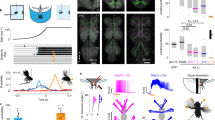Abstract
Like other flying animals, locusts must maintain course stability despite turbulence and motor errors. Accordingly, they must detect course deviations and then correct them. The compound eyes, the ocelli and the cephalic wind hairs all detect different sensory consequences of flight instability1–3,and descending interneurones bring this information to the thorax4–9. One such interneurone of this population (the tritocerebral commissure giant neurone) is known to elicit correctional steering10.Here we characterize three additional pairs of descending deviation detector neurones and show how their information is translated into altered drive to the flight motoneurones. The central pattern generator for flight11–13,modulated by proprioceptive feedback14, gates the signal of the detector neurones in thoracic premotor interneurones9,ensuring that the flight motoneurones are affected only during flight. Further, the gating process transforms the phase-independent information of the deviation detectors into a phase-dependent signal modulated at wing-beat frequency, and transfers it to those flight motoneurones active at the time and appropriate to the corrective action required.
This is a preview of subscription content, access via your institution
Access options
Subscribe to this journal
Receive 51 print issues and online access
$199.00 per year
only $3.90 per issue
Buy this article
- Purchase on Springer Link
- Instant access to full article PDF
Prices may be subject to local taxes which are calculated during checkout
Similar content being viewed by others
References
Weis-Fogh, T. Nature 163, 873–874 (1949).
Goodman, L. J. J. exp. Biol. 42, 385–408 (1965).
Taylor, C. P. J. exp. Biol. 93, 1–18 (1981).
Camhi, J. M. J. exp. Biol. 50, 349–369 (1969).
Kien, J. Vision Res. 14, 1255–1268 (1974).
Guy, R. et al. J. comp. Physiol. 115, 337–350 (1977).
Bacon, J. & Tyrer, M. J. comp. Physiol. 126, 317–325 (1978).
Simmons, P. J. exp. Biol. 85, 281–294 (1980).
Rowell, C. H. F. & Pearson, K. G. J. exp. Biol. 103, 265–288 (1983).
Möhl, B. & Bacon, J. J. comp. Physiol. 150, 453–466 (1983).
Wilson, D. M. J. exp. Biol. 38, 471–490 (1961).
Robertson, R. M. & Pearson, K. G. J. comp. Physiol. 146, 311–320 (1982).
Robertson, R. M. & Pearson, K. G. J. comp. Neurol. 215, 33–50 (1983).
Wendler, G. in Symp. Physiol. Biophys. Insect Flight Vol. 2 (ed. Nachtigall, W.) 113–125 (Fischer, Stuttgart, 1983).
Wilson, M. J. comp. Physiol. 124, 297–316 (1978).
Reichert, H. & Rowell, C. H. F. J. Neurophysiol. (in the press).
Zarnack, W. & Möhl, B. J. comp. Physiol. 118, 215–233 (1977).
Taylor, C. P. J. exp. Biol. 93, 19–31 (1981).
Wilson, D. M. J. exp. Biol. 48, 631–641 (1968).
Waldron, I. J. exp. Biol. 47, 213–228 (1967).
Burrows, M. & Horridge, G. A. Phil. Trans. R. Soc. B269, 49–94 (1974).
Goodman, L. J. J. exp. Biol. 42, 385–408 (1964).
Camhi, J. M. J. exp. Biol. 52, 519–532 (1970).
Gewecke, M. & Phillipson, J. Physiol. Ent. 3, 43–52 (1978).
Shepherd, G. M. Neurobiology, 395–412 (Oxford University Press, 1983).
Forssberg, H., Grillner, S. & Rossignol, S. Brain Res. 85, 103–107 (1975).
Grillner, S. Physiol. Rev. 55, 247–304 (1975).
Williams, J. L. D. thesis, Univ. Wales (1972).
Williams, J. L. D. J. Zool. 176, 67–86 (1975).
Goodman, C. S. Cell Tissue Res. 175, 166–183 (1976).
Goodman, L. J. in The Compound Eye and Vision in Insects (ed. Horridge, G. A.) 515–548 (Clarendon, Oxford, 1975).
Patterson, J. A. & Goodman, L. J. J. comp. Physiol. 95, 251–262 (1974).
Goodman, L. J. et al. Cell Tissue Res. 157, 467–492 (1975).
Simmons, P. J. J. comp. Physiol. 147, 401–414 (1981).
Stewart, W. W. Cell 14, 741–759 (1978).
Bacon, J. P. & Altman, J. S. Brain Res. 138, 359–363 (1977).
Author information
Authors and Affiliations
Rights and permissions
About this article
Cite this article
Reichert, H., Rowell, C. & Griss, C. Course correction circuitry translates feature detection into behavioural action in locusts. Nature 315, 142–144 (1985). https://doi.org/10.1038/315142a0
Received:
Accepted:
Issue Date:
DOI: https://doi.org/10.1038/315142a0
This article is cited by
-
How the humble insect brain became a powerful experimental model system
Journal of Comparative Physiology A (2017)
-
Visual response properties of neck motor neurons in the honeybee
Journal of Comparative Physiology A (2011)
-
Cellular substrates of action selection: a cluster of higher-order descending neurons shapes body posture and locomotion
Journal of Comparative Physiology A (2008)
-
Molecular correlates of neuronal specificity in the developing insect nervous system
Molecular Neurobiology (1993)
-
Locust flight steering
Journal of Comparative Physiology A (1992)
Comments
By submitting a comment you agree to abide by our Terms and Community Guidelines. If you find something abusive or that does not comply with our terms or guidelines please flag it as inappropriate.



